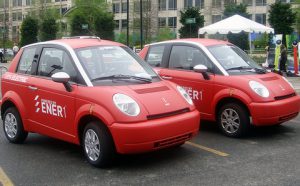Don DiConstanzo, owner of Pedego e-bikes in the suburban city of Irvine, California, only needs one word to explain the appeal of electric bicycles: hills. “I’m not in the business of selling electric bikes. I’m in the business of selling fun,” he says about the brand he founded six years ago to satisfy people like himself, aging baby boomers in need of fresh air and exercise, without too much sweat. “90% of our customers were done with cycling before they bought an electric bike,” he says.
In the United States (US), with its dominant car culture, e-biking is a niche pastime; a mere 180,000 e-bikes were sold in 2013. Low as it may seem, this number is almost double sales in 2012 as e-bikes begin to gain a foothold in the US’s vast sports and recreation market.
Already, a quarter of the nation’s traditional bike shops offer e-bikes and some 134 e-bike brands are offered in 900 specialty e-bike stores, where models range from cotton-candy pink to traditional black and prices can go up to US$10,000. Retailers like Wal-Mart and online giant Amazon offer affordable models for US$300 upwards.
In Europe, however, electric bikes are attracting droves of people who want a low-cost, low-hassle means of personal transport. Electric bikes do not require insurance, license fees, petrol or a parking space. Most electric bikes have a top speed of 20 miles per hour and their lightweight lithium-ion batteries can be charged from a household plug in a matter of hours. Electric bikes come in two varieties: one where the motor is activated by a throttle, independent of pedaling; the other is the ‘pedelec’, or pedal electric cycle in which the electric motor kicks in after a certain speed to help you pedal.
Frank Jamerson, an early e-bike enthusiast, has watched the e-bike market quickly evolve. When Jamerson began publishing the annual Electric Bikes Worldwide Reports (EBWR) in 1995, the market was in its infancy, worldwide sales were 110,000 and electric bikes tended to be, "slow, weak and expensive". From these meagre beginnings, worldwide sales of e-bikes have grown to 34 million in 2013. “Two-wheeled electric mobility is part of the future,” he says.
“In Europe, the product is getting much better and people are willing to pay €2,000-3,000 for a high-quality e-bike. In the Netherlands about 5% of the population already own an e-bike,” says Jamerson. In Europe’s densely populated cities, electric bikes work in tandem with public transport, moving commuters through the first and last kilometres of their journeys. Jamerson expects sales in Europe to grow to 2.6 million in 2016 from 1.5 million in 2012.
In 2011, German technology giant Bosch began offering an e-bike drive system, which consists of a motor, battery pack and electric controller – the three main elements of an electric bike that are added to a conventional bike. In three years it has become Europe’s most popular drive system supplier, providing drive systems to 62 brands.
China remains the world leader in electric bike sales, though, with a market that mushroomed from a few thousand in the 1990s to an estimated 170 million e-bikes in use today.
“Sales way exceeded my expectations. The market really took off due to the population’s greater spending power, the growth of home-grown businesses and the government’s ban or partial ban of gasoline-powered two-wheeled scooters,” Jamerson says.
The Chinese market is dominated by lower-end e-bikes that sell for between US$300-$400. These are one step-up from a conventional bike and are differentiated from the higher-end models by their bulky lead-acid batteries. China’s most successful e-bike companies include Jiangsu Yadea, Zhejiang LuYuan and Jiangsu Xinri, each of which make millions of e-bikes a year for the Chinese market.
Read also: Will China’s e-bike boom last?
Some of the world’s leading car manufacturers now offer their own electric bike models. Daimler AG, through its green subsidiary SMART USA, has an e-bike; BMW has the ‘Cruise’, launched in 2013, Audi has the Wörthersee and South Korean car manufacturer Kia is rolling out the Kia Electric Bicycle (KEB).
“My sense is that the car companies are using e-bikes to show they are green. They are not committed to it and they are not going into the e-bike business. They believe electric bikes are a gateway product to buying an electric car,” says DiConstanzo. That proved to be true for DiConstanzo himself, whose passion for electric mobility led him to buy a Tesla electric car. Still, he says, he rides his e-bike “every day”.
Car companies entering the e-bike market, even if it is as an afterthought, will be a boon for smaller e-bike brands, contracted to build the bikes that are sold through car companies’ vast dealership networks. DiConstanzo’s own Pedego bikes are sold in Ford dealerships under the name ‘Ford Super Cruiser’.
As early start-up e-bike companies failed and others were bought up by big conglomerates, the market has somewhat stabilised, according to Jamerson. In 2011, Currie Technologies, the US’s largest e-bike manufacturer was bought by Dutch company Accell Group, which offers 28 bike brands. Sales of e-bikes now account for over a third of Accell Group’s total bike sales.
In the past two years, 36 Pedego e-bike stores have opened and DiConstanzo expects 40 more to open this year. All of the stores are entrepreneur-owned and operated. Pedego does not franchise stores. Instead, he says, “we licence the brand to entrepreneurs interested in selling Pedego bicycles. We assist entrepreneurs with site selection, store design and marketing, but we do not charge a franchise fee”.
The business is already expanding into Europe, with stories in Italy and France. “A whole bunch of people all over the world now want to go back and forth to work on an e-bike,” says DiConstanzo.







